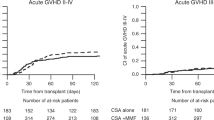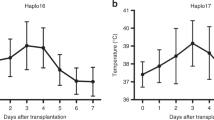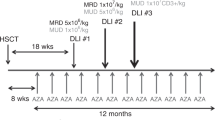Abstract
Mycophenolic acid (MPA) is the active component of mycophenolate mofetil (MMF). Low MPA exposure is associated with a higher incidence of acute GVHD and possibly worse engraftment. Therapeutic plasma targets have been proposed in hematopoietic cell transplantation (HCT), however, are difficult to achieve in adult patients with MMF doses of 2 g/day. Mycophenolate pharmacokinetics was prospectively studied in adults undergoing nonmyeloablative HCT who received MMF 3 g/day with CYA. The first 15 individuals received 1.5 g every 12 h and the second 15 received 1 g every 8 h. Sampling was performed in each patient with i.v. and oral administration. There were no differences in total or unbound MPA 24-h cumulative area under the curves (AUCs), concentrations at steady state (Css) or troughs between the two dosing regimens (all P>0.01). The previously proposed total MPA Css target of 3 μg/ml and trough ⩾1 μ/ml were achieved in only 13–27% and 20–53% of patients, respectively, on 3 g/day. However, the 3 g/day regimens readily achieved satisfactory unbound 24-h cumulative AUC targets of 0.600 μg*h/ml in 87–100% of subjects. There appears to be no significant difference in daily MPA exposure when MMF of 3 g/day is divided into two or three equal doses.
This is a preview of subscription content, access via your institution
Access options
Subscribe to this journal
Receive 12 print issues and online access
$259.00 per year
only $21.58 per issue
Buy this article
- Purchase on Springer Link
- Instant access to full article PDF
Prices may be subject to local taxes which are calculated during checkout

Similar content being viewed by others
References
Sorror ML, Storer BE, Maloney DG, Sandmaier BM, Martin PJ, Storb R . Outcomes after allogeneic hematopoietic cell transplantation with nonmyeloablative or myeloablative conditioning regimens for treatment of lymphoma and chronic lymphocytic leukemia. Blood 2008; 111: 446–452.
Rodriguez R, Nademanee A, Ruel N, Smith E, Krishnan A, Popplewell L et al. Comparison of reduced-intensity and conventional myeloablative regimens for allogeneic transplantation in non-Hodgkin's lymphoma. Biol Blood Marrow Transplant 2006; 12: 1326–1334.
Grosskreutz C, Scigliano E, Osman K, Isola L . Graft versus host disease after stem cell allotransplantation with low-dose total body irradiation, fludarabine, and antithymocyte globulin. Transplantation 2007; 84: 598–604.
Bullingham RE, Nicholls AJ, Kamm BR . Clinical pharmacokinetics of mycophenolate mofetil. Clin Pharmacokinet 1998; 34: 429–455.
Bullingham R, Monroe S, Nicholls A, Hale M . Pharmacokinetics and bioavailability of mycophenolate mofetil in healthy subjects after single-dose oral and intravenous administration. J Clin Pharmacol 1996; 36: 315–324.
Picard N, Ratanasavanh D, Premaud A, Le Meur Y, Marquet P . Identification of the UDP-glucuronosyltransferase isoforms involved in mycophenolic acid phase II metabolism. Drug Metab Dispos 2005; 33: 139–146.
Nowak I, Shaw LM . Mycophenolic acid binding to human serum albumin: characterization and relation to pharmacodynamics. Clin Chem 1995; 41: 1011–1017.
Staatz CE, Tett SE . Clinical pharmacokinetics and pharmacodynamics of mycophenolate in solid organ transplant recipients. Clin Pharmacokinet 2007; 46: 13–58.
Maris MB, Niederwieser D, Sandmaier BM, Storer B, Stuart M, Maloney D et al. HLA-matched unrelated donor hematopoietic cell transplantation after nonmyeloablative conditioning for patients with hematologic malignancies. Blood 2003; 102: 2021–2030.
Jenke A, Renner U, Richte M, Freiberg-Richter J, Platzbecker U, Helwig A et al. Pharmacokinetics of intravenous mycophenolate mofetil after allogeneic blood stem cell transplantation. Clin Transplant 2001; 15: 176–184.
Basara N, Blau WI, Kiehl MG, Schmetzer B, Bischoff M, Kirsten D et al. Mycophenolate mofetil for the prophylaxis of acute GVHD in HLA-mismatched bone marrow transplant patients. Clin Transplant 2000; 14: 121–126.
Giaccone L, McCune JS, Maris MB, Gooley TA, Sandmaier BM, Slattery JT et al. Pharmacodynamics of mycophenolate mofetil after nonmyeloablative conditioning and unrelated donor hematopoietic cell transplantation. Blood 2005; 106: 4381–4388.
Jacobson P, Rogosheske J, Barker JN, Green K, Ng J, Weisdorf D et al. Relationship of mycophenolic acid exposure to clinical outcome after hematopoietic cell transplantation. Clin Pharmacol Ther 2005; 78: 486–500.
Jeong H, Kaplan B . Therapeutic monitoring of mycophenolate mofetil. Clin J Am Soc Nephrol 2007; 2: 184–191.
van Gelder T, Le Meur Y, Shaw LM, Oellerich M, DeNofrio D, Holt C et al. Therapeutic drug monitoring of mycophenolate mofetil in transplantation. Ther Drug Monit 2006; 28: 145–154.
Knight SR, Morris PJ . Does the evidence support the use of mycophenolate mofetil therapeutic drug monitoring in clinical practice? A systematic review. Transplantation 2008; 85: 1675–1685.
van Hest RM, Hesselink DA, Vulto AG, Mathot RA, van Gelder T . Individualization of mycophenolate mofetil dose in renal transplant recipients. Expert Opin Pharmacother 2006; 7: 361–376.
Le Meur Y, Buchler M, Thierry A, Caillard S, Villemain F, Lavaud S et al. Individualized mycophenolate mofetil dosing based on drug exposure significantly improves patient outcomes after renal transplantation. Am J Transplant 2007; 7: 2496–2503.
Gaston R, Kaplan B, Meier-Kriesche H-U, Shaw L, Shah T, Patel D et al. Opticept Trial: efficacy and safety of monitored MMF in combination with CNI in renal transplantation at 12 months. Am J Transplantat 2008; 8 (Suppl 2): 319.
Brunstein CG, Barker JN, Weisdorf DJ, DeFor TE, Miller JS, Blazar BR et al. Umbilical cord blood transplantation after nonmyeloablative conditioning: impact on transplantation outcomes in 110 adults with hematologic disease. Blood 2007; 110: 3064–3070.
Cockcroft DW, Gault MH . Prediction of creatinine clearance from serum creatinine. Nephron 1976; 16: 31–41.
Jacobson PA, Green KG, Hering BJ . Mycophenolate mofetil in islet cell transplant: variable pharmacokinetics but good correlation between total and unbound concentrations. J Clin Pharmacol 2005; 45: 901–909.
van Hest RM, Doorduijn JK, de Winter BC, Cornelissen JJ, Vulto AG, Oellerich M et al. Pharmacokinetics of mycophenolate mofetil in hematopoietic stem cell transplant recipients. Ther Drug Monit 2007; 29: 353–360.
Bornhauser M, Schuler U, Porksen G, Naumann R, Geissler G, Thiede C et al. Mycophenolate mofetil and cyclosporine as graft-versus-host disease prophylaxis after allogeneic blood stem cell transplantation. Transplantation 1999; 67: 499–504.
Nash RA, Johnston L, Parker P, McCune JS, Storer B, Slattery JT et al. A phase I/II study of mycophenolate mofetil in combination with cyclosporine for prophylaxis of acute graft-versus-host disease after myeloablative conditioning and allogeneic hematopoietic cell transplantation. Biol Blood Marrow Transplant 2005; 11: 495–505.
Kiehl MG, Shipkova M, Basara N, Blau IW, Schutz E, Armstrong VW et al. Mycophenolate mofetil in stem cell transplant patients in relation to plasma level of active metabolite. Clin Biochem 2000; 33: 203–208.
Renner U, Platzbecker U, Freiderg-Richter J, Plettig R, Helwig A, Schafer K et al. Intravenous mycophenolate mofetil (MMF) after allogeneic blood stem cell transplantation. Results of a dose-finding study. Blood 1999; 94: 156a (abstract 681).
Jacobson P, Green K, Rogosheske J, Brunstein C, Ebeling B, Defor T et al. Highly variable mycophenolate mofetil bioavailability following nonmyeloablative hematopoietic cell transplantation. J Clin Pharmacol 2007; 47: 6–12.
Jacobson P, Huang J, Rydholm N, Tran M, Defor T, Tolar J et al. Higher mycophenolate dose requirements in children undergoing hematopoietic cell transplant (HCT). J Clin Pharmacol 2008; 48: 485–494.
Osunkwo I, Bessmertny O, Harrison L, Cheung YK, Van de Ven C, del Toro G et al. A pilot study of tacrolimus and mycophenolate mofetil graft-versus-host disease prophylaxis in childhood and adolescent allogeneic stem cell transplant recipients. Biol Blood Marrow Transplant 2004; 10: 246–258.
Haentzschel I, Freiberg-Richter J, Platzbecker U, Kiani A, Schetelig J, Illmer T et al. Targeting mycophenolate mofetil for graft-versus-host disease prophylaxis after allogeneic blood stem cell transplantation. Bone Marrow Transplant 2008; 42: 113–120.
Maris MB, Sandmaier BM, Storer BE, Maloney DG, Shizuru JA, Agura E et al. Unrelated donor granulocyte colony-stimulating factor-mobilized peripheral blood mononuclear cell transplantation after nonmyeloablative conditioning: the effect of postgrafting mycophenolate mofetil dosing. Biol Blood Marrow Transplant 2006; 12: 454–465.
Zucker K, Rosen A, Tsaroucha A, de Faria L, Roth D, Ciancio G et al. Unexpected augmentation of mycophenolic acid pharmacokinetics in renal transplant patients receiving tacrolimus and mycophenolate mofetil in combination therapy, and analogous in vitro findings. Transpl Immunol 1997; 5: 225–232.
Zucker K, Rosen A, Tsaroucha A, de Faria L, Roth D, Ciancio G et al. Augmentation of mycophenolate mofetil pharmacokinetics in renal transplant patients receiving Prograf and CellCept in combination therapy. Transplant Proc 1997; 29: 334–336.
Zucker K, Tsaroucha A, Olson L, Esquenazi V, Tzakis A, Miller J . Evidence that tacrolimus augments the bioavailability of mycophenolate mofetil through the inhibition of mycophenolic acid glucuronidation. Ther Drug Monit 1999; 21: 35–43.
Hesselink DA, van Hest RM, Mathot RA, Bonthuis F, Weimar W, de Bruin RW et al. Cyclosporine interacts with mycophenolic acid by inhibiting the multidrug resistance-associated protein 2. Am J Transplant 2005; 5: 987–994.
Vidal E, Cantarell C, Capdevila L, Monforte V, Roman A, Pou L . Mycophenolate mofetil pharmacokinetics in transplant patients receiving cyclosporine or tacrolimus in combination therapy. Pharmacol Toxicol 2000; 87: 182–184.
Weber LT, Shipkova M, Armstrong VW, Wagner N, Schutz E, Mehls O et al. The pharmacokinetic–pharmacodynamic relationship for total and free mycophenolic acid in pediatric renal transplant recipients: a report of the German study group on mycophenolate mofetil therapy. J Am Soc Nephrol 2002; 13: 759–768.
Kuypers DR, de Jonge H, Naesens M, de Loor H, Halewijck E, Dekens M et al. Current target ranges of mycophenolic acid exposure and drug-related adverse events: a 5-year, open-label, prospective, clinical follow-up study in renal allograft recipients. Clin Ther 2008; 30: 673–683.
Kaplan B, Gruber SA, Nallamathou R, Katz SM, Shaw LM . Decreased protein binding of mycophenolic acid associated with leukopenia in a pancreas transplant recipient with renal failure. Transplantation 1998; 65: 1127–1129.
Mudge DW, Atcheson BA, Taylor PJ, Pillans PI, Johnson DW . Severe toxicity associated with a markedly elevated mycophenolic acid free fraction in a renal transplant recipient. Ther Drug Monit 2004; 26: 453–455.
Acknowledgements
This work was supported by grants from the National Institutes of Health (NIH), National Cancer Institute 5K23CA096622 (PJ) and a seed grant from the University of Minnesota Academic Health Center (PJ). The expert technical assistance of Jason Dagit and Jim Fisher is gratefully acknowledged.
Author information
Authors and Affiliations
Corresponding author
Additional information
Disclosure
Drs Jacobson and Weisdorf have in the past received financial support from Roche Pharmaceuticals.
Rights and permissions
About this article
Cite this article
Jacobson, P., El-Massah, S., Rogosheske, J. et al. Comparison of two mycophenolate mofetil dosing regimens after hematopoietic cell transplantation. Bone Marrow Transplant 44, 113–120 (2009). https://doi.org/10.1038/bmt.2008.428
Received:
Revised:
Accepted:
Published:
Issue Date:
DOI: https://doi.org/10.1038/bmt.2008.428
Keywords
This article is cited by
-
Clinical Evidence on the Purported Pharmacokinetic Interactions between Corticosteroids and Mycophenolic Acid
Clinical Pharmacokinetics (2023)
-
Pharmacokinetics of intravenous mycophenolate mofetil in allogeneic hematopoietic stem cell-transplanted Japanese patients
Cancer Chemotherapy and Pharmacology (2018)
-
Clinical Pharmacokinetics of Mycophenolic Acid in Hematopoietic Stem Cell Transplantation Recipients
European Journal of Drug Metabolism and Pharmacokinetics (2017)
-
Pharmacokinetics, Pharmacodynamics, and Pharmacogenomics of Immunosuppressants in Allogeneic Hematopoietic Cell Transplantation: Part II
Clinical Pharmacokinetics (2016)
-
Optimizing drug therapy in pediatric SCT: Focus on pharmacokinetics
Bone Marrow Transplantation (2015)



